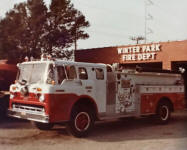
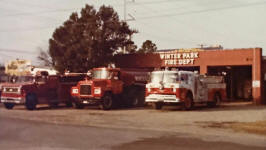
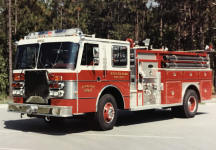
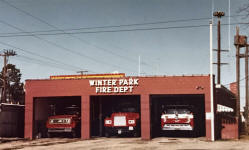
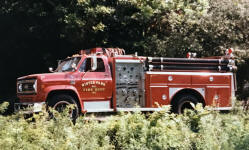
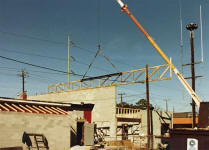
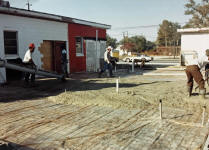
Photos courtesy Frank Blackley
| legeros.com > History > New Hanover County Fire History > Winter Park VFD |
Research notes by Mike Legeros
Last updated December 13, 2019
Change log: Added some vintage photos from Frank Blackley, December 13, 2019.
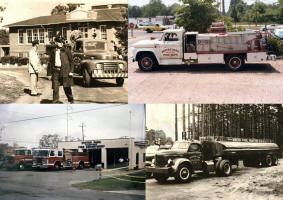
This narrative was written by Joan Stanfield, for the occasion of the department's 50th anniversary in 2001. The transcription is by Legeros, who has added headings and additional line breaks to improve readability.
[ It also includes annotations by Legeros in yellow. ]
Introduction
The long fight for adequate fire protection began in early 1951. The men of the Winter Park area had realized the need for fire protection and soon began to meet frequently at area churches, or the Winter Park Elementary School, to discuss the possibilities.
After months of meeting, enough interested men were gathered to proceed. Winter Park's first roster was constructed with the names of 31 determined men. While residents of the City of Wilmington had long received government provided fire services, the only fire protection provided by the county was in the form of two trucks located at the county airport.**
[ **The county's fire trucks were operated by a one-man FD. It was created in 1950, after the city stopped responding to fire calls outside the city that year. The county FD was based at the airport, and moved to Maffitt Village in 1951. ]
Members of the Wrightsboro community had only recently organized to create the county's first volunteer fire department**.
[ **Not quite correct... Seagate VFD was organized in 1940. ]
With dreams and determination, the men set out knocking on doors of homes and meeting with the operators of businesses asking for contributions to buy the first truck, and to equip it. While the process was slow, the men succeeded. Their dreams were becoming reality.
First Fire Truck
Early in 1952 the Winter Park Fire Protection Association was formed with a truck secured on loan from the City of Wilmington, a 1948 Ford. This began a long history of cooperative efforts with the city, a history that continues to this day. It was outfitted with whatever equipment the men could beg, buy, borrow, or make.
After several months they were able to purchase a truck from a local lumber company at half of its appraisal value. They sought $800.00 to convert the standard body of the truck to one capable of fighting fires. Frantically searching for funds, the men received a miraculous break: they needed money, [and] the [city] housing authority needed fire protection for Maffitt Village**.
[ **Maffitt Village was operating a VFD in 1950. The following year, they sold their fire truck to the county, and the county relocated its one-man fire department to Maffitt Village. The county ended its fire department in 1952. This action left Maffitt Village without fire protection. ]
The members of Winter Park received $800.00 as an immediate payment and $100.00 a month upon entering the first of many fire protection contracts that the next 50 years would hold. In its first year the truck answered 300 fire calls and traveled over 2500 miles**.
[ **Maffitt Village was approximately four road miles from the Winter Park fire station. ]
Two Engines - First Fire Rating
By October 1952 a truck capable of carrying 620 gallons was added to the fleet, and Winter Park had two engines on the road. It was at this point that Winter Park sought its first rating from the North Carolina Fire Insurance Rating Bureau.
While today's volunteer fire departments have the luxury of funding through a fire tax, the operations of the department were funded in part by membership dues from the firefighters, and by [household] subscription dues of $10.00.
First Fire Station
With a growing apparatus fleet, a station was required. Founding member and first chief Harry DeHart operated a Fountain Oil service station at Hugh McRae Park, and agreed to let this building serve as headquarters for the new department. A large siren was obtained from Civil Defense and mounted for operation. S.W. Brinson persuaded the reluctant DeHart to become chief. The 21 members were available to respond 24 hours.
Upon receipt of a call, Harry would sound the siren, lock up the station, and chalk the address of the call on a board outside the station. The chalkboard tradition lasted decades. Others, hearing the siren would rush to the station, note the address, and report for duty while Chief DeHart was enroute with the truck.
Two Years of Change
The next two years saw probably the greatest changes to occur at Winter Park until the arrival of a paid fire administrator and sweeping forced annexations four decades later.
In October 1952, New Hanover County signed a contract with Winter Park to furnish fire protection in an assigned area, and to provide assistance to other fledgling volunteer fire departments. In January of 1953, Winter Park allied with Ogden, Castle Hayne, Myrtle Grove, Seagate, Wrightsboro, and Maffitt Village Volunteer Fire Departments in a countywide volunteer association, known as the County Fire Protection Program.
April 1953 marked the arrival of the department's first 6,000-gallon tanker and was the beginning of a 40-year tradition of large tanker service provided by the station. The tanker was acquired from Comorotie Transport.
In July 1953, the department received its first insurance rating inspection, marking the beginning of insurance rate reduction for the district and the transition from a rural fire department classification to a volunteer fire department title. Mutual aid agreements became effective in late October 1953, almost coinciding with the department's first formal public fire education efforts during fire prevention week 1953.
Also in the fall of that year, in fact 50 years ago this very weekend, the department held the first of way too many fish frys to ever count. With the loss of the $100.00 per month from [the earlier contract with] the housing authority--Maffitt Village was now receiving protection from its own volunteer department**-- Winter Park relied on the fish fries to supplement the $65.00 a month provided by the county for the protection of 1250 homes and businesses. In March of 1954 they purchased another truck.
[ ** In 1954, the South Wilmington VFD was organized. It was located in Maffitt Village. ]
New Fire Station
On March 2, 1956, Chief Tommy Wood broke ground for a station to be built on a lot at 48th and Park Avenue acquired in May 1955. The contractor was William Newkirk, for 10% of the cost. The building costs were $7,000.00 ($46,000.00). It had a meeting room, three bays, a shed, and a storage room also used for cooking.
Open house and dedication came on July 7, 1956, with a five-piece band playing the National Anthem and Boy Scout Troop 229 raising the flag. Sherry Taylor, daughter of Fletcher Taylor, cut the ribbon. Reverend J.T. Maides of the Wesley Memorial Methodist church gave a message. All equipment and the station were paid for in their entirety.
Since its inception, the department had expended $30,869.46 on equipment and buildings. That's a lot of fish fries, and many knuckles bloodied from knocking on doors. The department was incorporated, and the roster now stood at 25 members. The fire siren was relocated, and had to be caged due to squirrel problems!
Ladies Auxiliary, Citizens Band Radios
The members' wives, cementing an already active role in the "family" of the fire station, formed a ladies Auxiliary in 1955. They assisted with much of the work of the fire station and also provided refreshments at the station' open house. The ladies met monthly in the homes of the members, then later moved meetings to the fire station in the 1970's.
The department sponsored a baseball team in the Winter Park Optimist Recreation League, as it did frequently into the 1990s.
By the early 1960s the department had purchased Citizens Band radio (only slightly less clear than the 800 MHz system we use today) and used these for emergency communications. Mrs. Jaye Munroe operated "Base Two" (call sign KKK-6044) from her home until Mrs. Joan Stanland began operating Base two from her home in 1972. FM Radios (call sign KIU-281) arrived in 1974, but a strong reliance on the CB radio remained. From the days of Chief DeHart and the chalkboard, communications have certainly changed.
Today voice pagers [that are] activated from a central public safety answering point [have] replaced a system in which Mr. Walter Moser activated the siren and a later system where an answering service took phone calls from members trying to establish the location of the call. Later, Joan Stanland also received the calls and a phone tree spread the word.
The Seventies and Eighties
In April of 1973, Julie Wight became the first female firefighter to join Winter Park.
Many traditions emerged in the station, including an annual awards banquet in June, and a Christmas party with home cooked meals and Santa arriving by fire truck.
Sadly, in spite of all efforts, the department has not been able to save every life. On the morning of February 25, 1976, Winter Park faced the first loss of life to fire within its district. The body of a woman in her fifties was found on her sofa bed, the victim of careless smoking.
In 1987 the fire station was remodeled. A full service kitchen, two dorms, two restrooms and showers were added.
New Firefighters, New Apparatus
In 1990, the fire station hosted its first resident firefighters, college students at UNCW. They lived at the station without costs, but were obligated to station duties and to be present to respond five nights of the week. In 1999, under the direction of the New Hanover County Department of Fire Services, Winter Park's volunteer staff was supplemented with a part-time paid county firefighter from 8 a.m. to 5 p.m., Monday through Friday.
In the early 1990s Winter Park sold its last woods firefighting vehicle, a Dodge Power Wagon, and was out of the woods firefighting business. Longer booster hoses were installed on the pumpers to compensate, but whatever could not be reached with the "red line" was left to the forestry service. Around the same time, Winter Park placed a mobile air unit into operation, a piece of equipment still exclusive to Winter Park.
In September 2001, the department received the fruits of a long battle for the safety of its firefighters. Just this week Winter Park took delivery of its first enclosed crew compartment fire engine. In doing so it left its status as the only volunteer department in the county unable to offer that protection to its personnel and improved the quality of service to its citizens.
Annexations
The first annexation to affect the department came in 1964, and brought the station itself into the city limits.** This annexation did not affect operations. Several recent annexations have steadily eroded the district served by Winter Park.
[ **The first annexation in December 1964 took the heart of the Winter Park fire district. In 1984, annexation took about a third of the district. In 2000, nearly all of the remaining district was annexed. The following year, Winter Park's small territory was assigned to Ogden VFD. The department continued to operate until 2005, when it disbanded. ]
Today, Winter Park provides primary fire protection to the residents of Springview, Churchill Estates, King's Grant Extension, and residential sections off the North Kerr Avenue corridor. We provide mutual aid to other county fire departments, and to the City of Wilmington on a regular basis. Tonight we celebrate fifty years of that service.
A scrapbook of the department's history was thoughtfully created by Mr. Robert "Bobby" Ingram, and was recently restored using its original cover by the Stanland family. A special thanks to Mrs. Joan Stanland for her work with the scrapbook, displayed here this evening, and with the details of this history.







Photos courtesy Frank Blackley
See home page, plus:
Copyright 2025 by Michael J. Legeros